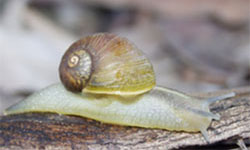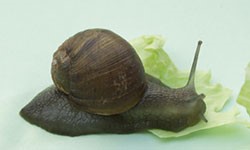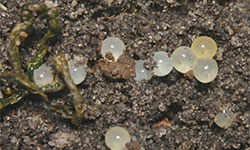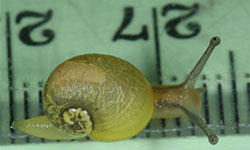Green snail
Green snail (Cornu apertus) is a declared exotic pest in Victoria and is a notifiable pest under Section 17 of the Plant Biosecurity Act 2010.
If you think you’ve seen green snail
If you know or have reason to suspect that green snail is present on any property in Victoria, you must notify Agriculture Victoria by calling 136 186 or emailing Market.Access@agriculture.vic.gov.au.
Notifications must be made within seven days of becoming aware or suspecting the presence of green snail.
Biology
Cornu apertus, (syn. Cantarues apertus, Helix aperta) or green snail typically has a life span of three years which includes several reproductive cycles. It can breed very quickly with up to 1000 young snails found per square metre.
The life cycle of the green snail is primarily influenced by day length and moisture, which control the duration of its aestivation (dormancy). After the autumn and winter rains, dormant snails emerge from the soil. Mature snails lay eggs in the soil around May or June, with young snails appearing in early winter. As the weather warms in spring and early summer, snails burrow into the soil, seal the entrance to their shells with a solid layer, and become dormant.
Unlike other snails, green snails enter the soil before becoming dormant. They remain in this state throughout the dry summer. When the autumn and winter rains return, the snails reactivate. Green snails are medium-sized compared to other snails. They are smaller than the common garden snail but larger than the vineyard snail and the white Italian snail. Their shell rarely grows larger than 25 mm in diameter.
The host range for green snail is very broad, and includes broadacre and horticultural crops such as cereals, canola, lucerne, pasture grasses, lupins, cultivated flowers, vegetables (such as cucurbits, brassicas, peas, beans, potatoes), nursery stocks and citrus.
Identifying green snail
Mature green snails have an olive-green shell and white flesh.
Green snail is a helicid snail that has a globular, thin and translucent shell of 3 to 4 whorls. It has an approximate height of 27 mm and width of 27 mm. The colour of the snail is generally pale, but it can often become dark green with maturity. Juvenile snails have an olive-green shell while mature snails have an olive-brown shell.
The snail causes damage similar to the common garden snail, which includes a ‘windowpane’ effect when it penetrates shallowly on young leaves as well as holes in leaves resulting from feeding.




Distribution in Australia
Green snail has been established in the Perth metropolitan area since the 1980s. It was first detected in Victoria in 2011 near Cobram in the northern region of the state. There have not been any detections outside this region since.
Movement pathways
Green snail can spread slowly via natural movement. However, they are primarily spread through the movement of plants, soil and equipment.
This includes but is not limited to:
- agricultural equipment and bins
- soil, plants and plant material (including cuttings and bare-rooted plants but not bare-rooted trees, provided they have no leaves or fruit)
- cut flowers
- pasture grasses
- hay, straw and other baled fodder
- leafy vegetables, peas, beans, asparagus, strawberries and strawberry plants
- turf.
Minimising the risk of spread
To minimise the risk of introducing green snail to your property, ensure all machinery, equipment and bins are appropriately cleaned of any plant material and soil before arriving on your property. Inspect all plants and plant products that arrive for the presence of green snail.
People that are operating land where green snail has been detected, or land that has been linked to a green snail detection, must also follow biosecurity measures to reduce the likelihood of the pest spreading further. A permit is required for movement of any green snail host materials from affected land.
Movement of green snail host materials from affected land
Legislation is enacted under the Plant Biosecurity Act 2010 to declare all parcels of land affected by green snail to be Restricted Areas in the Order declaring Restricted Areas in Victoria for the control of green snail.
All owners/operators of green snail affected land require a permit to move any potential green snail host materials off their land (including plants, fodder, machinery). If you require a permit, please contact Agriculture Victoria Plant Biosecurity on 1800 878 962 or use the regional contact details below.
Northern Region
Plant Quarantine
Email: plant.quarantine@agriculture.vic.gov.au
Phone: 1800 878 962
South East Region
Plant Standards
Email: plant.standards@agriculture.vic.gov.au
Phone: 1800 878 962
South West Region
Plant Standards South West
Email: plant.southwest@agriculture.vic.gov.au
Phone: 1800 878 962
Moving green snail host materials out of Victoria
Interstate trade regulations exist to prevent the spread of green snail into other states and territories. Contact the relevant state authority for more information regarding interstate entry requirements and market access visit the Quarantine regulators page.
Requirements that must be met when bringing plants and plant products into Victoria.
For more information on the requirements that must be met when bringing plants and plant products into Victoria visit the Moving Plants and Plant Products page.
Moving green snail host materials into Victoria - Victoria’s Plant Quarantine Manual
To assist with complying with Victoria’s movement condition requirements when importing green snail host material into the state, Agriculture Victoria’s online Plant Quarantine Manual provides you with advice on entry conditions for plant and plant products.
Reporting an unusual plant insect pest or disease
Report any unusual plant pest or disease immediately using our online reporting form or by calling the Exotic Plant Pest Hotline on 1800 084 881. Early reporting increases the chance of effective control and eradication.
Please take multiple good quality photos of the pests or damage to include in your report where possible, as this is essential for rapid pest and disease diagnosis and response.
Your report will be responded to by an experienced staff member, who may seek more information about the detection and explain next steps.
Report online